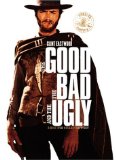Synopsis
Three men are after a fortune in gold, and they will stop at nothing to get it. Boiled down toits essentials, that is the plot of TGTBTU. Granted, there are all sorts of betrayals anddouble-crosses along the way, but they don’t change the fact that the story is essentially a verysimple one, and you might wonder how the film takes up three hours. It certainly doesn’t throughcharacter development. In fact, there is very little that sets the characters apart (which is par… ofthe ironic point of the title): Lee Van Cleef is completely Bad, but Eastwood is only Good in thesense that he never actively tries to kill Eli Wallach, who is certainly Ugly, but for all hisuntrustworthiness is more human and easier to sympathize with than Eastwood’s cold-eyedmachine. The film is three hours long because it takes just about every imaginable iconic westernset piece, and pushes these moments to their breaking point. Everything culminates in the lastword in stand-offs, a magisterial tour de force where the suspense builds to an almost hystericallevel, driven solely by the frenzy of Ennio Morricone’s score and the hysteria of the editing.
Most of the restored footage in this version was available on the pervious DVD release, butwasn’t integrated back into the film. At the risk of sounding heretical, I will say that, though interesting, the scenes don’t add very much to thefilm, and the case could be made that the previous North American version was a tighter work.Wallach’s scenes with his gang, for instance, may explain how he catches up with Eastwoodlater, but that explanation was never necessary, and the film’s forward movement is stopped deadby this sequence.
Audio
Provided here is the “original Italian mono” — which isn’t to say that Van Cleef, Wallach andEastwood originally spoke Italian. Italian films are almost always post-synched, so the word“original” is a little dubious here. Of more interest is the new 5.1 English. Morricone’s score ismajestic as it never has been, even granting a certain thinness of sound inevitable with a filmfrom 1966. The surround effects are rather few and far between, and are rather low key whenthey do show up, even in such cataclysmic scenes as the trench warfare sequence. On the otherhand, the left-right placement of sound is excellent, and often amusing (watch the moment whereWallach first appears, and you’ll see what I mean).
Video
The 2.35:1 anamorphic image isn’t pristine, but it is as close as one could reasonably hope,and the opening credits are the best I’ve ever seen them. There is some grain in the rest of thefilm (but again, remember that this is 1966), and there is no visible edge enhancement. The close-ups are as sweaty and sharp as one could possibly wish. There is a little shudder in the picturenow and then, but this is a very minor detail.
Special Features
On Disc 1, critic and historian Richard Schickel provides an informed, enlighteningcommentary, and he has the time to go expand at length on most aspects of the film.
Disc 2 is a collection of featurettes, ranging in length from 7 minutes (the one on Morricone)to 23 (“The Leone Style”). “Leone’s West” and “The Leone Style” are both making-of features,with memories from Eastwood, Wallach and others. While the latter does focus a bit more onLeone’s aesthetic choices, it also covers lots of nuts-and-bolts stuff too, such as how positivelydangerous some of the shoot was. “The Man Who Lost the Civil War” is a context-providing bitof history, outlining the events that form the backdrop of the film. Ennio Morricone gets his duewith “Il Maestro,” and host Jon Burlingame provides a much more in-depth look at the score inan audio-only companion piece. “Reconstructing The Good, the Bad and the Ugly is apretty technical look at the restoration. On that subject, there are also two deleted scenes. One is alonger version of the torture of Wallach, which was too badly damaged for be restored in full,and the other is a reconstruction of the Socorro sequence that never appeared in any version ofthe film. Some snippets of it exist in the French trailer, which is provided in this section of themenu.
As for promotional material, Disc 2 itself has a poster gallery and the original theatricaltrailer, while accompanying the discs are four quite lovely international poster cards. There is yetmore printed material in the form of an essay by Roger Ebert in the accompanying booklet.Finally, there’s the usual handful of trailers for other MGM releases. The menus on the discshave fully scored and animated intros, main screens and transitions.
Closing Thoughts
If this film isn’t the ultimate western, it’s a serious contender for the title. If you haven’tseen it, you don’t know what you’re missing.
Special Features List
- Audio Commentary
- “Leone’s West” Making-of Featurette
- “The Leone Style” Featurette
- “”The Man Who Lost the Civil War” Documentary
- “Reconstructing The Good, The Bad and The Ugly” Featurette
- “Il Maestro: Ennio Morricone and The Good, the Bad and the Ugly” Featurette
- Poster Gallery
- International Mini-Posters
- Theatrical Trailer
- 8-page Booklet
- Bonus Trailers
- Deleted Scenes






